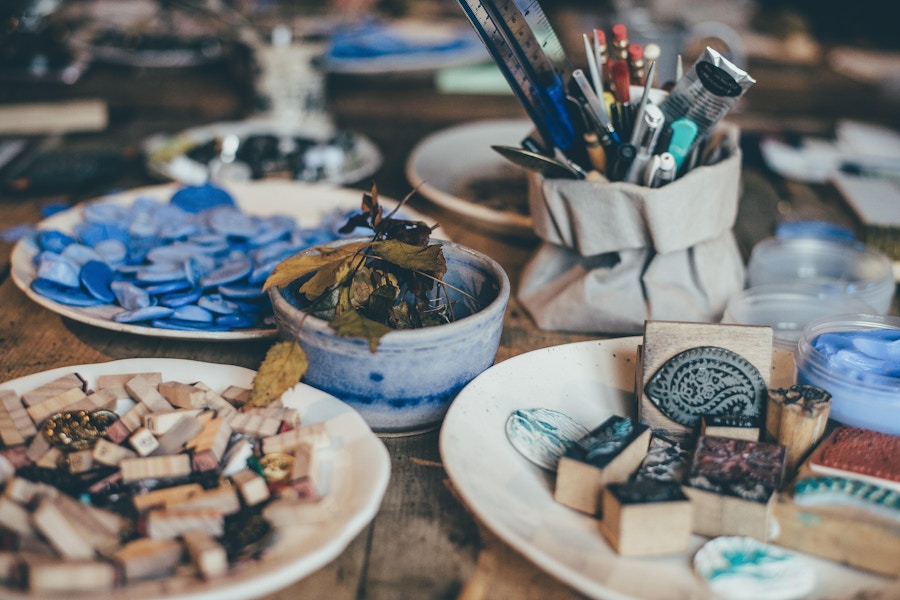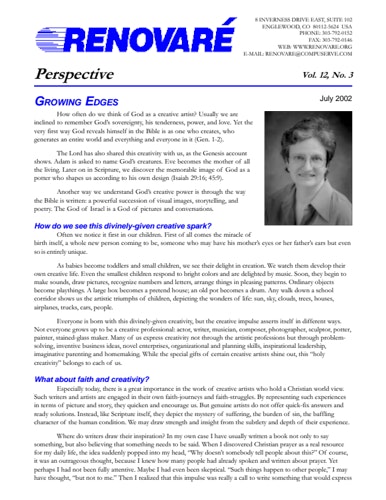Introductory Note:
In remembrance of our dear friend, Emilie Griffin, we share this post in which she reminds us that God is a creative artist, and that each of us—as his image-bearers—have received a divinely-given creative spark. “Creative artists stand within The Incarnational Tradition,” she writes, “showing us God’s presence in all the work we do. By the creative works we do and the created works we appreciate, we give glory to God. Our lives are the richer for it.”
Renovaré Team
How often do we think of God as a creative artist? Usually we are inclined to remember God’s sovereignty, his tenderness, power, and love. Yet the very first way God reveals himself in the Bible is as one who creates, who generates an entire world and everything and everyone in it (Gen. 1 – 2).
The Lord has also shared this creativity with us, as the Genesis account shows. Adam is asked to name God’s creatures. Eve becomes the mother of all the living. Later on in Scripture, we discover the memorable image of God as a potter who shapes us according to his own design (Isaiah 29:16; 45:9).
Another way we understand God’s creative power is through the way the Bible is written: a powerful succession of visual images, storytelling, and poetry. The God of Israel is a God of pictures and conversations.
How do we see this divinely-given creative spark?
Often we notice it first in our children. First of all comes the miracle of birth itself, a whole new person coming to be, someone who may have his mother’s eyes or her father’s ears but even so is entirely unique.
As babies become toddlers and small children, we see their delight in creation. We watch them develop their own creative life. Even the smallest children respond to bright colors and are delighted by music. Soon, they begin to make sounds, draw pictures, recognize numbers and letters, arrange things in pleasing patterns. Ordinary objects become playthings. A large box becomes a pretend house; an old pot becomes a drum. Any walk down a school corridor shows us the artistic triumphs of children, depicting the wonders of life: sun, sky, clouds, trees, houses, airplanes, trucks, cars, people.
Everyone is born with this divinely-given creativity, but the creative impulse asserts itself in different ways. Not everyone grows up to be a creative professional: actor, writer, musician, composer, photographer, sculptor, potter, painter, stained-glass maker. Many of us express creativity not through the artistic professions but through problem-solving, inventive business ideas, novel enterprises, organizational and planning skills, inspirational leadership, imaginative parenting and homemaking. While the special gifts of certain creative artists shine out, this “holy creativity” belongs to each of us.
What about faith and creativity?
Especially today, there is a great importance in the work of creative artists who hold a Christian world view. Such writers and artists are engaged in their own faith-journeys and faith-struggles. By representing such experiences in terms of picture and story, they quicken and encourage us. But genuine artists do not offer quick-fix answers and ready solutions. Instead, like Scripture itself, they depict the mystery of suffering, the burden of sin, the baffling character of the human condition. We may draw strength and insight from the subtlety and depth of their experience.
Where do writers draw their inspiration? In my own case I have usually written a book not only to say something, but also believing that something needs to be said. When I discovered Christian prayer as a real resource for my daily life, the idea suddenly popped into my head, “Why doesn’t somebody tell people about this?” Of course, it was an outrageous thought, because I knew how many people had already spoken and written about prayer. Yet perhaps I had not been fully attentive. Maybe I had even been skeptical. “Such things happen to other people,” I may have thought, “but not to me.” Then I realized that this impulse was really a call to write something that would express my own experience of prayer. At the time I was conceiving the book, I could not fully explain to others what I was doing. I would say, “I want to write a book like the mystics wrote, in which you feel the depth and mystery of prayer.” Or, “My book is going to be something like those sketch-book instruction manuals, the ones that tell you how to draw cats. Because I want to draw a picture of prayer.” I called the book Clinging: the Experience of Prayer, and “clinging” was only one of the poetic comparisons and images I used to describe prayer. My hope was to make prayer vivid and real for others as it had suddenly become to me.
I believe that all artists of faith entertain the hope of illuminating the life of grace. Writers and other creative artists stand within The Incarnational Tradition, showing us God’s presence in all the work we do. By the creative works we do and the created works we appreciate, we give glory to God. Our lives are the richer for it.
Growing Together
How can we become more aware of our creative gifts? Here are some simple creative exercises worth trying. In some cases they require you to write or draw. In others you may simply be appreciating works of art or music created by others. Try to return to an attitude in which you are not self-critical. Don’t worry about whether you can write or draw proficiently. Instead, concentrate on the pleasure of expressing an idea, or simply seeing the flow of your pen on the page, or the brightness of magic markers on the paper. Be sure you have some good creative tools that are inexpensive — magic markers, newsprint pads, inexpensive paper. (I remember once using a roll of shelf-paper and magic markers when my children were young; it looked like so much fun I had to try it!) Maybe your spiritual formation group or a friend or two can join together to do some special creative exercises, or engage in ways to appreciate your own creativity and that of great artists of faith.
Writing
Remember what Henri Nouwen says about writing as a tool for spiritual development: “Writing is a process in which we discover what lives in us. The writing itself reveals to us what lives in us. The deepest satisfaction of writing is precisely that it opens up new spaces within us of which we were not aware before we began to write.”
• Write new words to a familiar song. “O My Darling Clementine” is a good melody if you can’t think of one. Don’t plan to write about faith; know that you exercise faith in the composing of the words.
• Write a letter to God. Thank him for your creative gifts, and for the gift of your faith.
• Write a brief history of your childhood memories of coming to know God. Can you remember an idea about God that you have outgrown?
• Begin a journal. Choose a fresh composition book and plan to write an entry every day for a week. Make sketches, too, if you like. Read your journal over to yourself or to friends and decide at the end of the week whether to continue.
Designing/Visual Creativity
• Rearrange your desk to make it more attractive or spacious. Get rid of the clutter. Add a picture, a vase of flowers, a lamp. Enjoy your handiwork.
• Arrange a centerpiece of flowers for the day your spiritual formation group meets. Reflect on the beauty and color of the flowers.
• Set the table creatively for a meal. Use an attractive centerpiece or create one.
• Set out a new row of plants in your garden, or arrange potted plants on an indoor shelf.
• Draw a picture of your workplace and reflect on what it may reveal to you about your daily work.
• Draw a picture of something or someone you find beautiful: a flower, a tree, a person.
Performing Arts
• Share a favorite music CD with friends. Reflect with them on why it pleases you.
• View a movie that makes you really happy. Two possibles are “Singin’ in the Rain” and “It’s a Wonderful Life.”
• Tell simple, familiar stories like “Sleeping Beauty” and “Hansel and Gretel,” and enjoy the storytelling.
• Tell Bible stories from memory.
Faith-Reflection with a Work of Art
• Search out a painting or another work of art that has special meaning for you. Spend some time in appreciation of the work. Then consider writing, or explaining to another person, why this work is so meaningful for you. The late Henri Nouwen had a particular appreciation of Rembrandt’s painting, “The Return of the Prodigal Son.” I have had a similar experience with Stanley Spencer’s painting, “The Resurrection: Cookham,” which depicts the general resurrection as it might occur in Spencer’s own home village in England.
• Try a similar encounter with great musical works of faith. A CD of great Christian hymns might offer such an opportunity. Handel’s “Messiah” in performance or on CD can offer a glimpse of the resurrected life.
Photo by Annie Spratt on Unsplash
Text First Published July 2002 · Last Featured on Renovare.org October 2022



